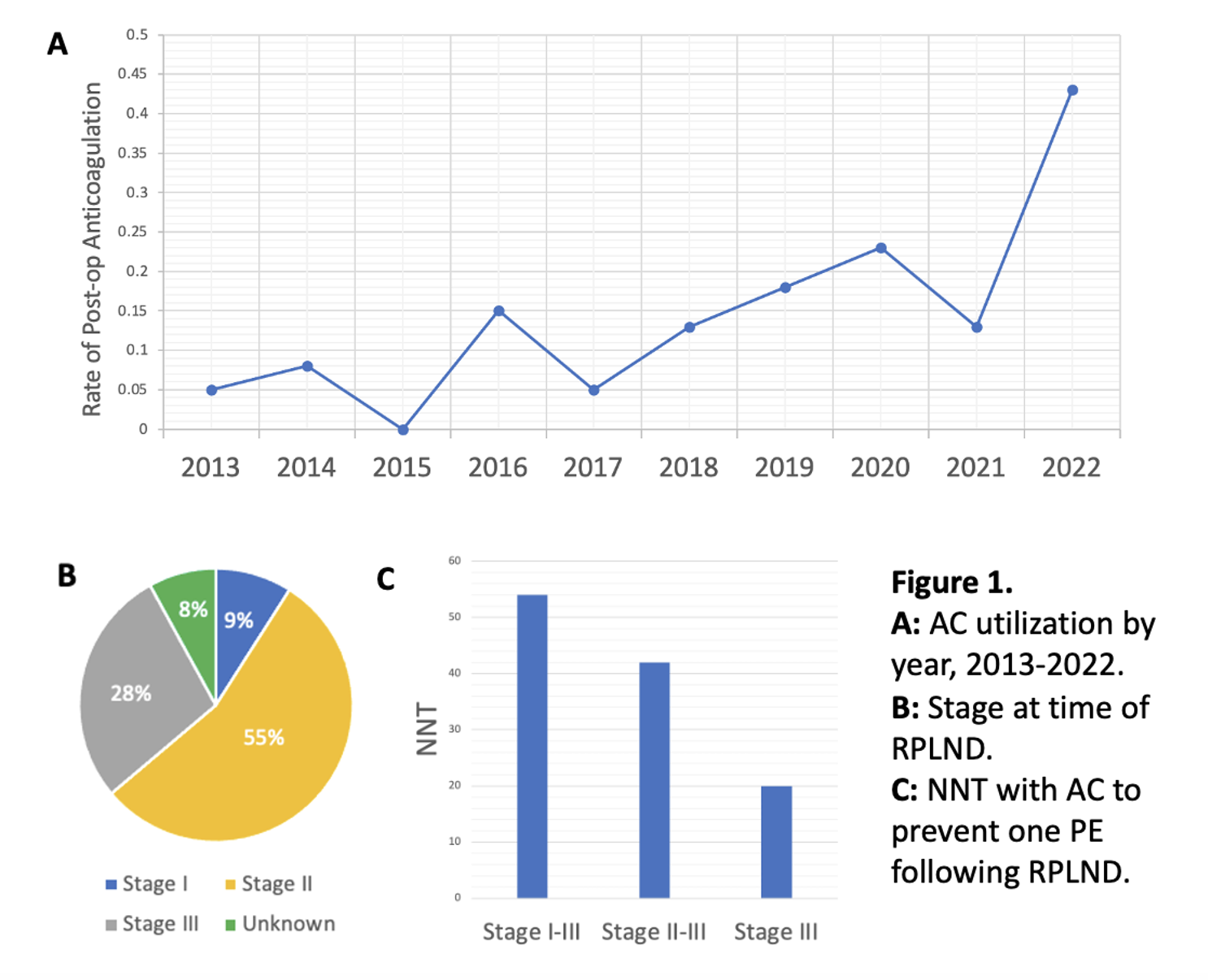Back
Introduction: The rate of post-operative pulmonary embolism (PE) following retroperitoneal lymph node dissection (RPLND) is roughly 1%. The safety and efficacy of post-op anticoagulation (AC) prophylaxis following RPLND has been debated and there is no consensus recommendation. The aim of this study is to evaluate patterns related to the safety and efficacy of post-op AC following RPLND in the past 10 years.
Methods: Using an institutional database, patients who underwent RPLND between the dates of 2013-2022 were identified. Data including demographics, clinical stage at RPLND, post-op AC status, episodes of post-op PE, follow-up time, and testis cancer-related mortality were collected. The number needed to treat was calculated and compared for post-op AC utilization and development of PE, stratified by clinical stage.
Results: 188 total patients underwent RPLND for testis cancer between 2013-2022. Median age was 31. Median follow-up time was 25 months. 75% of patients were post-chemotherapy. Testis cancer-related mortality over the follow-up period was 8% (n=13). The rate of post-op AC increased from 5% in 2013 to 43% in 2022 (p=0.01) (Figure 1a). No patients discharged on AC developed a post-op PE within 6 months of discharge. There were 3 post-op PE reported within 6 months of RPLND. There was one separate DVT event which did not result in PE. Of patients diagnosed with a post-operative PE, one patient was treated with therapeutic AC, one patient required thrombectomy, and one patient died due to PE-related complications. There was one patient (not treated with post-op AC) who had a transfusion-requiring post-op bleed. There were 17 patients with Stage I, 103 patients with Stage II, and 53 patients with Stage III disease at the time of RPLND (Figure 1b). All PE events occurred in patients with clinical stage IIB or higher disease. Assuming treatment effect due to post-op AC, the number needed to treat (NNT) to prevent one PE was 54, 42, and 20 for all patients, =Stage II patients, and Stage III patients, respectively (Figure 1c).
Conclusions: The rate of post-operative AC following RPLND has increased over the past 10 years. Retrospective analysis suggests a benefit of post-op AC, especially for patients with higher stage disease, and further prospective studies are needed to demonstrate efficacy. SOURCE OF
Funding: None.

Moderated Poster Session
Session: MP33: Penile and Testicular Cancer I
MP33-13: Anticoagulation Prophylaxis Patterns following Retroperitoneal Lymph Node Dissection: A Ten-Year Retrospective Analysis
Saturday, April 29, 2023
9:30 AM – 11:30 AM CST
Location: S404C

Vincent D. D'andrea, MD (he/him/his)
Brigham & Women's Hospital, Harvard Medical School
Poster Presenter(s)
Introduction: The rate of post-operative pulmonary embolism (PE) following retroperitoneal lymph node dissection (RPLND) is roughly 1%. The safety and efficacy of post-op anticoagulation (AC) prophylaxis following RPLND has been debated and there is no consensus recommendation. The aim of this study is to evaluate patterns related to the safety and efficacy of post-op AC following RPLND in the past 10 years.
Methods: Using an institutional database, patients who underwent RPLND between the dates of 2013-2022 were identified. Data including demographics, clinical stage at RPLND, post-op AC status, episodes of post-op PE, follow-up time, and testis cancer-related mortality were collected. The number needed to treat was calculated and compared for post-op AC utilization and development of PE, stratified by clinical stage.
Results: 188 total patients underwent RPLND for testis cancer between 2013-2022. Median age was 31. Median follow-up time was 25 months. 75% of patients were post-chemotherapy. Testis cancer-related mortality over the follow-up period was 8% (n=13). The rate of post-op AC increased from 5% in 2013 to 43% in 2022 (p=0.01) (Figure 1a). No patients discharged on AC developed a post-op PE within 6 months of discharge. There were 3 post-op PE reported within 6 months of RPLND. There was one separate DVT event which did not result in PE. Of patients diagnosed with a post-operative PE, one patient was treated with therapeutic AC, one patient required thrombectomy, and one patient died due to PE-related complications. There was one patient (not treated with post-op AC) who had a transfusion-requiring post-op bleed. There were 17 patients with Stage I, 103 patients with Stage II, and 53 patients with Stage III disease at the time of RPLND (Figure 1b). All PE events occurred in patients with clinical stage IIB or higher disease. Assuming treatment effect due to post-op AC, the number needed to treat (NNT) to prevent one PE was 54, 42, and 20 for all patients, =Stage II patients, and Stage III patients, respectively (Figure 1c).
Conclusions: The rate of post-operative AC following RPLND has increased over the past 10 years. Retrospective analysis suggests a benefit of post-op AC, especially for patients with higher stage disease, and further prospective studies are needed to demonstrate efficacy. SOURCE OF
Funding: None.

